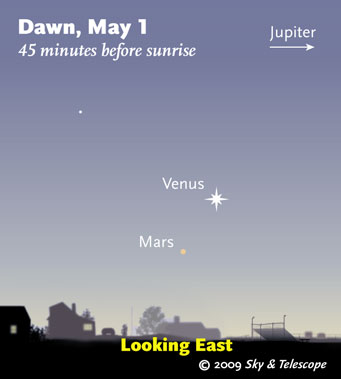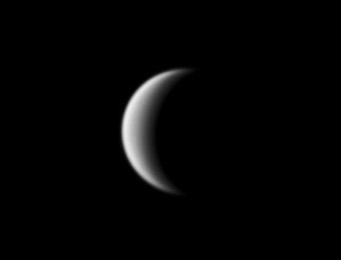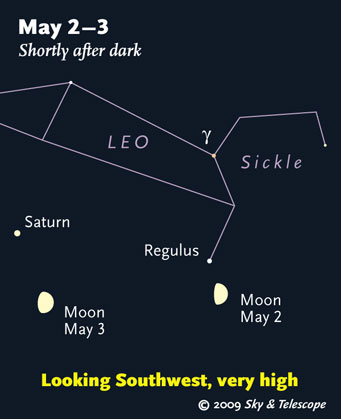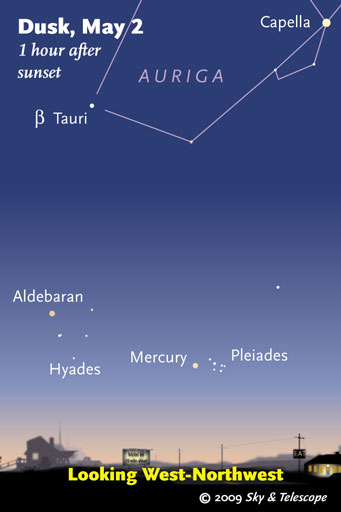Some daily events in the changing sky for April 24 – May 2.
Comet Yi-SWAN isn't much at magnitude 8½, but it's nearly circumpolar — crossing northern Perseus. It's low in the northwest right after dark, and low in the northeast right before the first light of dawn. See our AstroAlert with the comet's positions for plotting on your star atlas.

Venus is only about 5° from faint Mars low in the eastern dawn. (The visibility of Mars in bright twilight is exaggerated here.)
Sky & Telescope diagram
Friday, April 24
Saturday, April 25
Will this sighting set your personal young-Moon record? The crescent will be only about 21 hours from new at viewing time from the East Coast of North America, and 24 hours from new as seen from the West Coast. Have you ever seen a crescent this young? (Calculate from the exact time of new Moon under Friday above.)
Sunday, April 26
Monday, April 27
Tuesday, April 28

Have you tried looking for Venus with your scope in broad daylight after sunrise? Sean Walker shot this stacked-video image of Venus at 10:04 a.m. Eastern Daylight Time on Sunday, April 26th. He used a 12.5-inch reflector, a DMK21AU04.AS camera, and a Baader 300–400nm ultraviolet filter. Venus's crescent was 21% illuminated at the time.
S&T: Sean Walker
Wednesday, April 29
Thursday, April 30
Friday, May 1
More or less. The actual midpoint between this year's March equinox and June solstice comes on May 5th, at 4:45 p.m. Eastern Daylight Time.

The Moon shines under Regulus on May 2nd and Saturn on May 3rd. (These scenes are drawn for the middle of North America. European observers: move each Moon symbol a quarter of the way toward the one for the previous date. In the Far East, move it halfway. For clarity, the Moon is shown three times actual size.)
Sky & Telescope diagram
Saturday, May 2
Want to become a better amateur astronomer? Learn your way around the constellations. They're the key to locating everything fainter and deeper to hunt with binoculars or a telescope. For an easy-to-use constellation guide covering the whole evening sky, use the big monthly map in each issue of Sky & Telescope, the essential magazine of astronomy. Or download our free Getting Started in Astronomy booklet (which only has bimonthly maps).
Sky Atlas 2000.0 (the color Deluxe Edition is shown here) plots 81,312 stars to magnitude 8.5. That includes most of the stars that you can see in a good finderscope, and typically one or two stars that will fall within a 50× telescope's field of view wherever you point. About 2,700 deep-sky objects to hunt are plotted among the stars.
Alan MacRobert
Once you get a telescope, to put it to good use you'll need a detailed, large-scale sky atlas (set of charts; the standards are Sky Atlas 2000.0 or the smaller Pocket Sky Atlas) and good deep-sky guidebooks (such as Sky Atlas 2000.0 Companion by Strong and Sinnott, the more detailed and descriptive Night Sky Observer's Guide by Kepple and Sanner, or the classic Burnham's Celestial Handbook). Read how to use them effectively.
Can a computerized telescope take their place? I don't think so — not for beginners, anyway, and especially not on mounts that are less than top-quality mechanically. As Terence Dickinson and Alan Dyer say in their Backyard Astronomer's Guide, "A full appreciation of the universe cannot come without developing the skills to find things in the sky and understanding how the sky works. This knowledge comes only by spending time under the stars with star maps in hand and a curious mind." Without these, they note, "the sky never becomes a friendly place."
More beginners' tips: "How to Start Right in Astronomy".
This Week's Planet Roundup

By May 1st and 2nd, the Pleiades slide down to pose directly to Mercury's right. Don't confuse Mercury with Aldebaran, a little higher.
Sky & Telescope diagram
Mercury, low in evening twilight, fades rapidly from about magnitude 0 to +1.5 this week. Look for it low in the west-northwest about an hour after sunset. As the sky gets darker, the Pleiades glimmer into view very near it. The Pleiades are above Mercury early in the week, and to the right of it by May 1st and 2nd, as shown here.
Venus (magnitude –4.7) shines low in the east during dawn. Don't confuse it with Jupiter, higher and far to the right in the southeast. In a telescope, Venus is a thickening, shrinking crescent. The best telescopic views come in full early-morning daylight, when Venus is higher in steadier air.
Mars (only magnitude +1.2) remains about 5° from Venus all week. It's below Venus early in the week, and lower left of it toward the week's end. Bring binoculars.
Mars is beginning a long, slow apparition that will find it at opposition on January 29, 2010.
Jupiter (magnitude –2.2, in Capricornus) shines in the southeast before and during dawn.
Saturn (magnitude +0.7, in Leo) is high in the south during evening. Regulus, not quite as bright, sparkles 16° (roughly one and a half fist-widths at arm's length) more or less to Saturn's right.
In a telescope, Saturn's rings appear 4° from edge on, their widest for the year.
Uranus (6th magnitude) is hidden low in the sunrise glow, in the background of Venus — and 17,000 times fainter.
Neptune (8th magnitude) is the background of Jupiter — and 11,000 times fainter.
Pluto (14th magnitude, in northwestern Sagittarius) is highest in the south before the first light of dawn. It's 250 times fainter than Neptune.
All descriptions that relate to your horizon or zenith — including the words up, down, right, and left — are written for the world's mid-northern latitudes. Descriptions that also depend on longitude (mainly Moon positions) are for North America. Eastern Daylight Time (EDT) equals Universal Time (known as UT, UTC, or GMT) minus 4 hours.
To be sure to get the current Sky at a Glance, bookmark this URL:
http://SkyandTelescope.com/observing/ataglance?1=1
If pictures fail to load, refresh the page. If they still fail to load, change the 1 at the end of the URL to any other character and try again.
 0
0
Comments
You must be logged in to post a comment.